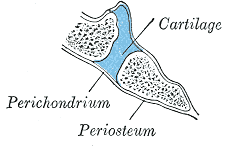Classification of Joints
Editor-In-Chief: Prab R Tumpati, MD
Obesity, Sleep & Internal medicine
Founder, WikiMD Wellnesspedia &
W8MD medical weight loss NYC and sleep center NYC
Anatomy > Gray's Anatomy of the Human Body > III. Syndesmology > 3. Classification of Joints
Henry Gray (1821–1865). Anatomy of the Human Body. 1918.
Classification of Joints[edit | edit source]
In human anatomy, the classification of joints (or articulations) is based on the structure of the joint and the type and degree of movement it permits. Joints are generally categorized into three major classes:
- Synarthroses – immovable joints
- Amphiarthroses – slightly movable joints
- Diarthroses – freely movable joints
Synarthroses (Immovable Joints)[edit | edit source]
Synarthroses are joints where adjacent bones are connected by fibrous tissue or hyaline cartilage, with no appreciable movement. These are typical of joints found in the skull, except for the temporomandibular joint.
There are four primary types of synarthrosis:
Suture[edit | edit source]
A fibrous joint found exclusively in the skull. Sutures are further classified as:
- Sutura dentata – interlocking, tooth-like projections (e.g., between parietal bones)
- Sutura serrata – saw-like articulating edges (e.g., between the frontal bone halves)
- Sutura limbosa – beveled overlapping margins (e.g., coronal suture)
- Sutura squamosa – overlapping beveled edges (e.g., squamous suture)
- Sutura harmonia – simple apposition without interlocking (e.g., between maxillae)
Schindylesis[edit | edit source]
A joint where a thin plate of bone is inserted into a fissure between two other bones (e.g., rostrum of sphenoid articulating with the vomer).
Gomphosis[edit | edit source]
A peg-and-socket joint, seen in the teeth articulating with the alveolar process of the maxilla or mandible.
Synchondrosis[edit | edit source]
A cartilaginous joint where bones are connected by hyaline cartilage. It is typically temporary and ossifies with age. Examples include:
- Spheno-occipital synchondrosis
- Epiphyseal plates in long bones
Amphiarthroses (Slightly Movable Joints)[edit | edit source]
These joints allow limited movement and are connected by fibrocartilage or interosseous ligaments. The two major forms are:
- Symphysis – fibrocartilaginous joint (e.g., intervertebral discs, pubic symphysis)
- Syndesmosis – bones joined by a ligament or interosseous membrane (e.g., distal tibiofibular joint)
Diarthroses (Freely Movable Joints)[edit | edit source]
Diarthroses (also called synovial joints) represent the majority of joints in the body and allow a wide range of motion. Characteristic features include:
- Articular cartilage
- Synovial membrane
- Joint capsule
- Synovial fluid
- Optional structures like menisci and articular discs
Types of Diarthroses (Synovial Joints)[edit | edit source]
Ginglymus (Hinge Joint)[edit | edit source]
Permits flexion and extension in one plane. Example: elbow joint, interphalangeal joints.
Trochoid (Pivot Joint)[edit | edit source]
Allows rotation around a longitudinal axis. Examples:
Condyloid joint (Ellipsoidal Joint)[edit | edit source]
Allows movement in two planes (flexion, extension, adduction, abduction). Example: radiocarpal joint (wrist).
Saddle joint (Articulatio sellaris)[edit | edit source]
Opposing surfaces are concavo-convex, permitting biaxial movement. Example: carpometacarpal joint of the thumb.
Ball and socket joint (Enarthrosis)[edit | edit source]
Multiaxial joint allowing movement in all directions. Examples: hip joint, shoulder joint.
Gliding joint (Arthrodia)[edit | edit source]
Flat or slightly curved surfaces that allow limited gliding. Examples:
- Zygapophyseal joints (between vertebrae)
- Carpal bones (excluding capitate with lunate)
See also[edit | edit source]
External links[edit | edit source]
- Anatomy photo:20:st-2002 at the SUNY Downstate Medical Center
| Human systems and organs | ||||||||||||||
|---|---|---|---|---|---|---|---|---|---|---|---|---|---|---|
|
| Joints | ||||||||
|---|---|---|---|---|---|---|---|---|
|
| Fibrous joints of the human skull | ||||||
|---|---|---|---|---|---|---|
|
| Joints and ligaments of the arm | ||||||||
|---|---|---|---|---|---|---|---|---|
|
| Joints and ligaments of the human leg | ||||||||||||||
|---|---|---|---|---|---|---|---|---|---|---|---|---|---|---|
|
Gray's Anatomy[edit source]
- Gray's Anatomy Contents
- Gray's Anatomy Subject Index
- About Classic Gray's Anatomy
- Glossary of anatomy terms
Anatomy atlases (external)[edit source]
[1] - Anatomy Atlases
| Human systems and organs | ||||||||||||||
|---|---|---|---|---|---|---|---|---|---|---|---|---|---|---|
|
Adapted from the Classic Grays Anatomy of the Human Body 1918 edition (public domain)
Search WikiMD
Ad.Tired of being Overweight? Try W8MD's physician weight loss program.
Semaglutide (Ozempic / Wegovy and Tirzepatide (Mounjaro / Zepbound) available.
Advertise on WikiMD
|
WikiMD's Wellness Encyclopedia |
| Let Food Be Thy Medicine Medicine Thy Food - Hippocrates |
Translate this page: - East Asian
中文,
日本,
한국어,
South Asian
हिन्दी,
தமிழ்,
తెలుగు,
Urdu,
ಕನ್ನಡ,
Southeast Asian
Indonesian,
Vietnamese,
Thai,
မြန်မာဘာသာ,
বাংলা
European
español,
Deutsch,
français,
Greek,
português do Brasil,
polski,
română,
русский,
Nederlands,
norsk,
svenska,
suomi,
Italian
Middle Eastern & African
عربى,
Turkish,
Persian,
Hebrew,
Afrikaans,
isiZulu,
Kiswahili,
Other
Bulgarian,
Hungarian,
Czech,
Swedish,
മലയാളം,
मराठी,
ਪੰਜਾਬੀ,
ગુજરાતી,
Portuguese,
Ukrainian
Medical Disclaimer: WikiMD is not a substitute for professional medical advice. The information on WikiMD is provided as an information resource only, may be incorrect, outdated or misleading, and is not to be used or relied on for any diagnostic or treatment purposes. Please consult your health care provider before making any healthcare decisions or for guidance about a specific medical condition. WikiMD expressly disclaims responsibility, and shall have no liability, for any damages, loss, injury, or liability whatsoever suffered as a result of your reliance on the information contained in this site. By visiting this site you agree to the foregoing terms and conditions, which may from time to time be changed or supplemented by WikiMD. If you do not agree to the foregoing terms and conditions, you should not enter or use this site. See full disclaimer.
Credits:Most images are courtesy of Wikimedia commons, and templates, categories Wikipedia, licensed under CC BY SA or similar.
Contributors: Anish, Prab R. Tumpati, MD






